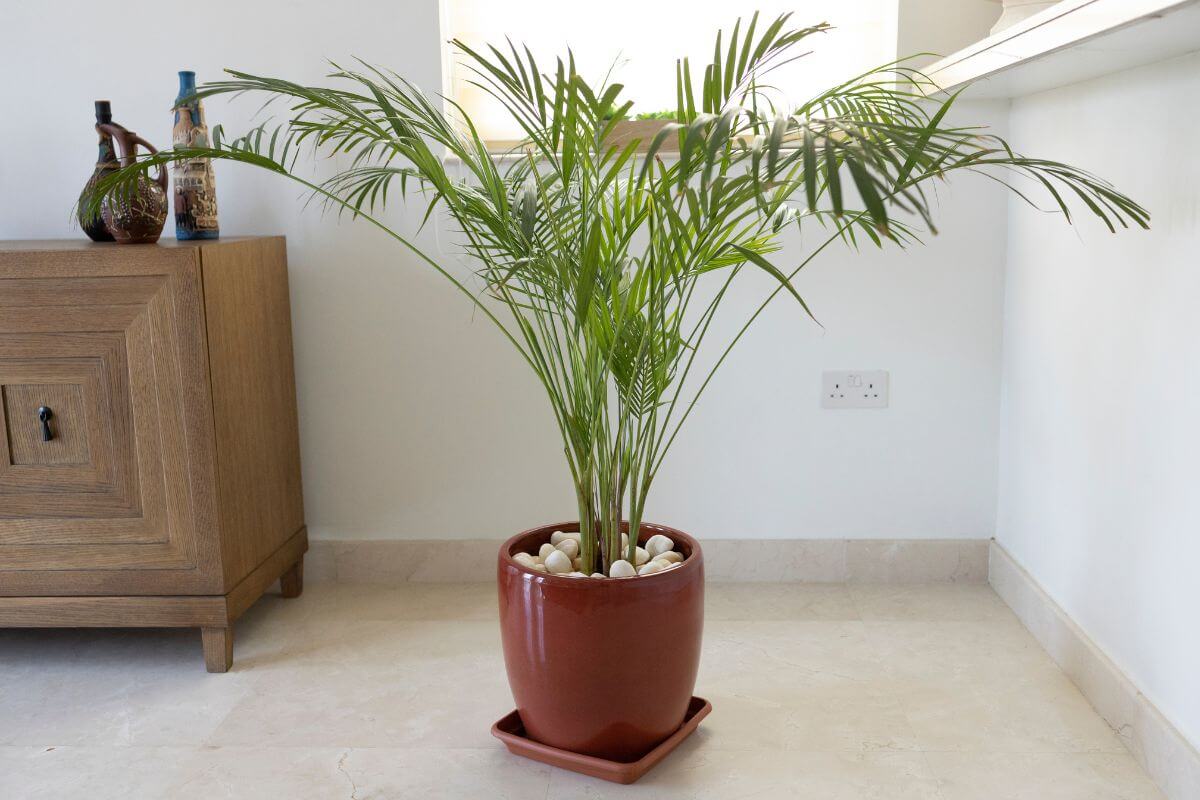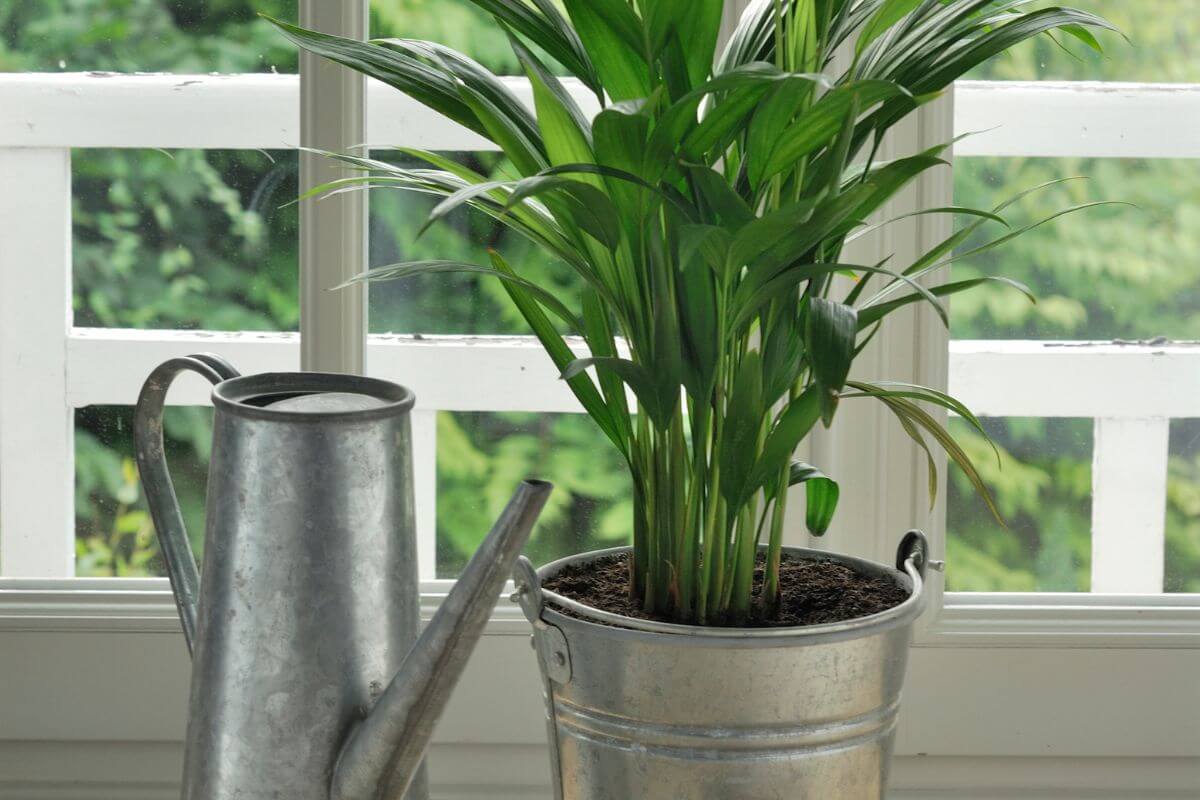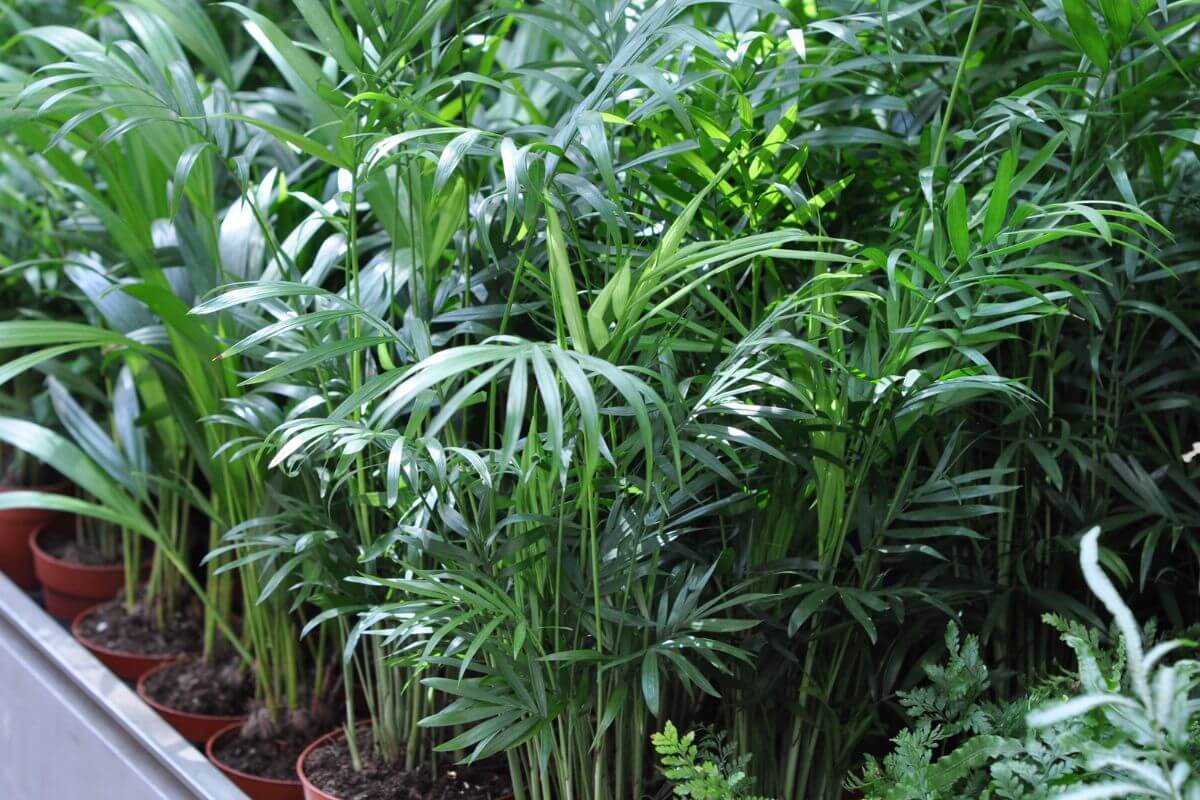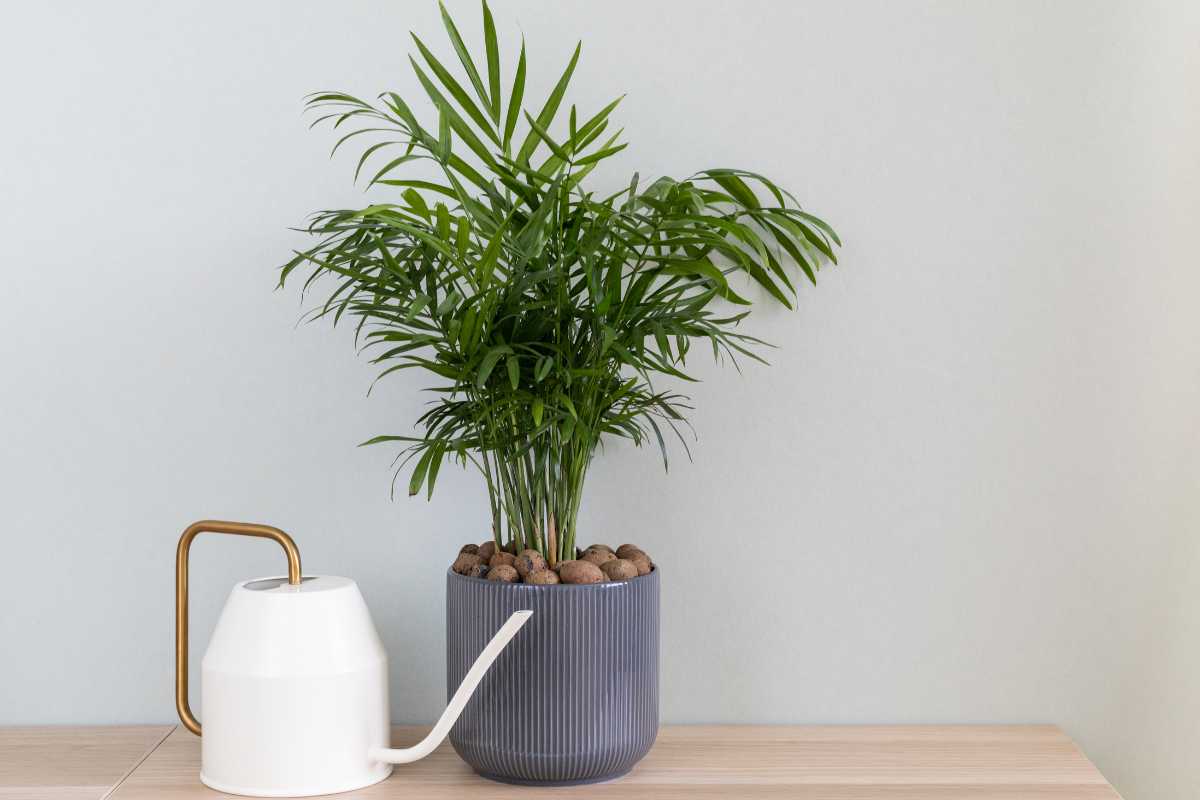The Bamboo Palm is a favorite for both indoor and outdoor spaces, with its lush, green leaves and ability to thrive in low light.
In this guide, we’ll cover everything you need to know about growing and caring for the bamboo palm. From the best soil and light conditions to watering and feeding tips, we’ve got you covered. We’ll also touch on the different varieties of bamboo palms and how to deal with any pests that might try to make themselves at home.
Ready to bring a bit of the tropics into your life? Let’s dive into the world of bamboo palms and discover how easy they are to care for. Whether you’re a seasoned gardener or a newbie, you’ll find all the information you need to keep your bamboo palm happy and healthy.
7 Key Takeaways on Bamboo Palm
- Bamboo palms thrive in bright, indirect light and can grow both indoors and outdoors with minimal care.
- They are ideal for low-light indoor environments and can reach up to 20 feet tall outdoors, though they generally stay around 7 feet indoors.
- Bamboo palms are non-toxic to humans and pets, but their berries are poisonous if ingested.
- These palms are excellent air purifiers, removing toxins such as formaldehyde, ammonia, and benzene from indoor air.
- They prefer well-draining, slightly acidic soil and consistent moisture, avoiding waterlogged conditions.
- Regular fertilization during the growing season with a balanced, slow-release fertilizer promotes healthy growth.
- Bamboo palms are easy to propagate from offshoots, which is faster than growing from seeds.
Bamboo Palm Overview

Bamboo palms are great both as houseplants and garden plants. Their scientific name is Chamaedorea seifrizii, and they are known for liking low light. Originally from Mexico, Guatemala, and Honduras, they belong to the Araceae family like the philodendrons and peace lilies.
- Read more: Peace Lily Grow and Care Guide
These palms have beautiful green pinnate leaves. Some types have tiny or joined leaflets, and others have leaves that shine with blue and green colors. No matter the type, bamboo palms usually stay small.
Bamboo palms have a unique trait: their flowers don’t smell. They’re dioecious, which means there are separate male and female plants. Each type of plant has its own blooms. The flowers are yellow. The female plants grow orange fruit that turns black when ripe.
You don’t need to do much to take care of bamboo palm leaves. Just cut back the old or dying leaves, snip the brown tips, and remove any bare canes.
You can grow bamboo palms inside or outside. They like rich, well-draining soil that is a bit acidic, but they can adapt to different soil types. They thrive in zones 10 and 11 and can survive winters in USDA zones 8b and warmer.
The stems and leaves of bamboo palms are safe for pets and people. However, the berries from the female flowers can be harmful. If you have pets or kids, it’s best to pick the berries as soon as they appear.
How to Care for Your Bamboo Palm
The bamboo palm is a low-maintenance plant, making it ideal for beginners or those without a great deal of time to dedicate to indoor gardening.
Those are the environmental conditions to grow a bamboo palm plant successfully.
Bamboo Palm Soil Requirements

For the indoor bamboo palm tree, an acidic soil bed of good-quality, well-draining potting soil mixed with organic material like peat moss (see latest prices) is ideal. This combination helps retain some moisture without creating overly moist soil that could harm the plant.
Repotting can be done as needed. Choose a new pot that is one size larger than the current one. When repotting, gently remove the old soil from the root ball and trim off any dead or damaged roots.
To grow bamboo palm trees outside, plant them at the end of spring or the beginning of summer in a shaded location. Use well-draining soil mixed with compost, humus, or decomposed manure.
Prepare the soil surface by watering the spot at least a day in advance. This helps ensure the soil is not too dry and is ready for planting.
Bamboo Palm Light Requirements
Like so many popular houseplants, this type of palm will thrive in bright, indirect light conditions. In their native habitat, these palms grow underneath other plants and trees, receiving dappled natural light.
As a result, bamboo palms have great tolerance for heavy shade, making them perfect for indoor locations with low light, whether natural or artificial.
However, extremes of direct sunlight exposure can lead to leaf burn, so it’s best to avoid placing them in bright light.
Similarly, very dark locations should be avoided. To help your palm achieve overall beauty, turn it partially every week so that all the foliage can access similar lighting conditions.
Bamboo Palm Temperature Requirements
Bamboo palms thrive best in a moderate temperature range from 65° to 75° Fahrenheit. They can adapt to temperatures slightly above or below this range for short periods.
For outdoor cultivation, it’s important to plant them in areas where temperatures do not fall below 55°F for extended periods. Bamboo palms perform well under sunny conditions and require consistent wet conditions to flourish.
Bamboo Palm Humidity Requirements

Bamboo palms thrive in humid environments, so if you’re growing one indoors, it’s beneficial to mist it occasionally.
To enhance humidity, consider using a pebble tray or a small humidifier, which helps maintain the moist conditions that bamboo palms need.
Cold and dry conditions are not ideal for these plants, as they prefer consistently moist and humid environments to stay healthy and happy.
Bamboo Palm Watering Requirements
Bamboo palms thrive in moist soil, but it’s important to avoid soggy, waterlogged conditions. Ensure that your plant’s pot has unblocked drainage holes to prevent standing water, which can lead to root rot.
When checking the soil, it should feel barely damp to the touch. If it’s dry a third to halfway down, it’s time to water. When watering, let excess water drain thoroughly and avoid leaving any water at the bottom of the pot.
Using rainwater or distilled water is preferable, as treated municipal water may contain salts and chemicals that can harm the plant. If you notice salt buildup on the soil surface, flush it with rainwater and allow it to drain completely.
Overwatering can cause bamboo palm leaves to fade, yellow, turn brown, and drop, while new growth may be pale. If this happens, you might need to address potential root or stem rot.
Underwatering, on the other hand, will result in brown leaf tips and reduced growth. To remedy this, trim off the brown tips and give the plant a thorough soaking, allowing the excess water to drain out.
Fertilizer for Bamboo Palm
Fertilizing bamboo palms is essential for their growth and health, especially during their active growing seasons in spring and summer. Use a balanced, slow-release fertilizer with an NPK ratio around 14-14-14 or 10-10-10 for container plants.
For those planted in the ground, opt for a high nitrogen fertilizer like 16-8-4 in the spring and summer, and switch to a higher phosphorus and potassium fertilizer, such as 3-18-18, during fall and winter.
Application rate for container plants:
- 1-gallon planter – 1 Tbsp
- 5-gallon planter – 2 Tbsp
- 15-gallon planter – 1/4 Cup
- 25-gallon planter – 1/2 Cup
Application rate for ground plantings:
- Apply 1 cup per 64 sq ft monthly in spring or summer
- Apply 2 cups per 64 sq ft every 6 weeks in fall or winter
Start by diluting the fertilizer to half or a quarter of the manufacturer’s strength. Fertilize container plants every 4-6 months and ground plantings monthly in spring/summer and every 6 weeks in fall/winter.
To avoid fertilizer burn, ensure the your bamboo palm’s soil is moist before application. Do not fertilize if the plant is not actively growing or if the soil is very dry.
As an alternative, composted horse manure can serve as a natural fertilizer for ground plantings. Apply it about 4 inches deep in late fall every other year to provide a beneficial nutrient boost.
Bamboo Palm Propagation
Bamboo palms can be propagated efficiently through offshoots, which is often faster than starting from seeds. Most palm species will be grown from seed, but it is a long, drawn-out process. Even the smallest common palms among nursery plants will be several years old.
Here are some tips to help you with the process:
- Care and Growth – Monitor the offshoot for a couple of months. Ensure it remains in a warm, humid location and keep the soil consistently moist but not waterlogged.
- Cutting the Offshoot – Use a sharp garden knife to carefully cut a section of the offshoot along with its roots from the existing bamboo palm.
- Potting the Offshoot – Put the offshoots in loamy, well-draining soil, and it should adapt in 2-3 months.
- Creating a Humid Environment – Keep the potted offshoot in a humid environment to encourage rooting and growth. You can use a plastic cover or place the pot in a tray of water to maintain humidity.
Bamboo Palm Pests
Bamboo palms are rugged plants with very few problems.
However, in a container setting, leaf burn can occur due to excessive salt buildup from water and fertilizer. Solutions include repotting the plant to refresh the soil or leaching the soil by flushing the pot with water until it runs clear.
Palms are susceptible to spider mites, especially during hot and dry seasons, which can be identified by small webbing on leaf edges.
- Learn more: Do Houseplants Attract Bugs?
If plants are outdoors, washing the leaves with a heavy stream of water can remove spider mites. Alternatively, they can be treated with insecticidal soap or horticultural oil.
Mealybugs and scale can occasionally infest bamboo palms and can be treated with horticultural soap or oil. Regular inspection and prompt treatment can help keep these pests under control.
Types of Bamboo Palm

The bamboo palm genus includes over 100 different species to select from. Here are 9 bamboo palm varieties that you can choose from:
| Palm Type | Scientific Name | Description | Care Requirements |
|---|---|---|---|
| Bamboo Palm | Chamaedorea seifrizii | Native to Mexico and Central America, it has slender, bamboo-like stems and can reach 6.5 feet tall with a 3-6 feet spread. Purifies air by removing toxins. | Prefers rich, well-draining soil, consistent moisture, and thrives in low light. |
| Cat Palm | Chamaedorea cataractarum | Bushy palm with multiple stems from the base. Grows up to 6 feet tall. | Requires bright, indirect light, high humidity, well-draining soil, and regular watering. |
| Cauqui Palm | Chamaedorea plumosa | Features feather-like fronds and can grow up to 10 feet tall. | Grows best in partial shade with well-draining soil. Moderate watering is needed, allowing the top inch of soil to dry between waterings. |
| Dwarf Bamboo Palm | Chamaedorea radicalis | Smaller palm growing 3-4 feet tall with bamboo-like stems and dark green leaves. | Thrives in low to medium light with well-draining soil and regular watering. |
| Hardy Bamboo Palm | Chamaedorea microspadix | Tolerates temperatures as low as 20°F and grows up to 8 feet tall. | Prefers partial shade, well-draining soil, and regular watering without overwatering. Suitable for USDA zones 8-11. |
| Miniature Fishtail Palm | Chamaedorea metallica | Has metallic blue-green leaves resembling a fishtail and grows up to 4-6 feet tall. | Prefers rich, well-draining soil, and consistent moisture, and thrives in low light. |
| Pacaya Palm | Chamaedorea tepejilote | Native to Central America, can grow up to 20 feet tall, with an edible inflorescence. | Prefers partial shade, well-draining soil, and regular watering to keep the soil moist. |
| Parlor Palm | Chamaedorea elegans | Compact indoor palm growing 4-6 feet tall with slender stems and arching fronds. Effective at purifying air. | Thrives in low to medium light, and needs well-draining soil and regular watering, allowing the top inch of soil to dry out. |
| Velvet Palm | Chamaedorea arenbergiana | Known for its soft, velvety fronds, it grows up to 6 feet tall. | Prefers low to medium light, well-draining soil, and regular watering to keep the soil moist. |
Bamboo Palm Care Final Thoughts
Bamboo palms are a dream for indoor plant lovers like me. I’ve found they’re happy in spots with less light, which makes them perfect for my apartment. You’ll love how they thrive in filtered light, bringing a tropical vibe to any room.
If you’re lucky enough to live in Zones 10 or 11, you can grow these beauties outdoors too. Just pick a shady spot with good drainage. Trust me, your bamboo palm won’t thank you for full sun exposure.
Bamboo Palm Care FAQs
1. Does The Bamboo Palm Need Sun?
The bamboo palm prefers bright but indirect sunlight, mimicking its native tropical habitats where it grows under the dappled light of larger trees.
2. Is The Bamboo Palm Easy To Care For?
Yes, the bamboo palm is easy to care for. It thrives with plenty of indirect light and regular watering. If signs of stress, such as wilting, appear, repot the plant immediately.
3. Is The Bamboo Palm Lucky?
The bamboo palm is considered to bring good fortune due to its long, thin leaves. However, it is different from the lucky bamboo, which is more traditionally associated with good luck. The bamboo palm requires minimal care and maintenance.
4. How Tall Will A Bamboo Palm Grow?
Outdoors, bamboo palms can reach up to 20 feet tall with adequate space and attention. Indoors, they typically grow to about 7 feet.
5. Is The Bamboo Palm Poisonous To Humans?
No, the bamboo palm’s leaves are not poisonous to humans or pets. However, the berries produced by the plant are toxic and should not be ingested.
6. Is The Bamboo Palm An Air Purifier?
Yes, the bamboo palm is an effective air purifier. It helps remove toxins such as formaldehyde, ammonia, benzene, and trichloroethylene from indoor air.
Explore these additional guides on houseplant care:





